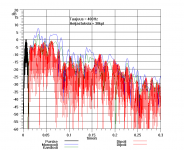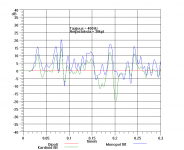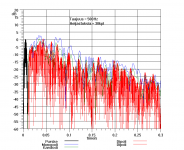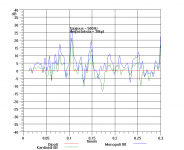Correction to my previous posting #291
The room simulation software CARA seems to be available also in English.- my version simply does not to support multi language
http://www.cara.de/ENU/CARA/index.php?load=menu.html
Michael
The room simulation software CARA seems to be available also in English.- my version simply does not to support multi language
http://www.cara.de/ENU/CARA/index.php?load=menu.html
Michael
Hello,
Since many years ago I've made my own room simulation software based on image modelling. It can analyse room in time domain in order to reveal the temporal aspects of sounds in a room. It is not much of a point to analyse room resonse in steady state situation as it is usually done since in reality we don't listen to sinusoids with infinite length (well if somebody does that I give no disregard to him). Music is no steady state and it should be taken into account when analysing the loudspeaker-room combination.
I'm favouring loudspeakers with directivity at low freqs (below 1kHz) and dipole is a very practical way to achieve directivity in this freq range.
Dipoles will give me more detail from the recording since there is less room masking so dipole will deliver me more recording and less listening room. This is one of the things I want, hence I use dipoles.
- Elias
Since many years ago I've made my own room simulation software based on image modelling. It can analyse room in time domain in order to reveal the temporal aspects of sounds in a room. It is not much of a point to analyse room resonse in steady state situation as it is usually done since in reality we don't listen to sinusoids with infinite length (well if somebody does that I give no disregard to him). Music is no steady state and it should be taken into account when analysing the loudspeaker-room combination.
I'm favouring loudspeakers with directivity at low freqs (below 1kHz) and dipole is a very practical way to achieve directivity in this freq range.
Dipoles will give me more detail from the recording since there is less room masking so dipole will deliver me more recording and less listening room. This is one of the things I want, hence I use dipoles.
- Elias
Hello,
Let me present some results from time domain room simulation.
The room in question is 7m*4m*2.5m (length*width*hight) in size. The 4m wall is the front wall. Loudspeaker is place 1m from the front wall and 0.5m from side wall. Listener is placed on the longitudal mid axis 3m from back wall.
Reflection coefficients of walls, ceiling and floor are between 0.8-0.98 (wood and concrete).
This simulation contains >220000 image sources.
Loudspeakers included in this simulation are monopole, dipole and cardioid (placed at the same position). The loudspeaker model contains only the directivity pattern without other features. Main axis of dipole and cardioid is pointing to the listener.
The input signal is 5 cycles of raised cosine envelope sinudoid at simulation frequency.
First simulation is at 400Hz, so input signal duration is 12.5ms (black in colour).
The direct sound will arrive to the listener at about 10ms. Directly after this monopole (blue) response will expand heavily as more reflections arrive to the listening position. Cardioid (green) is somewhere between monopole and dipole.
- Elias
Let me present some results from time domain room simulation.
The room in question is 7m*4m*2.5m (length*width*hight) in size. The 4m wall is the front wall. Loudspeaker is place 1m from the front wall and 0.5m from side wall. Listener is placed on the longitudal mid axis 3m from back wall.
Reflection coefficients of walls, ceiling and floor are between 0.8-0.98 (wood and concrete).
This simulation contains >220000 image sources.
Loudspeakers included in this simulation are monopole, dipole and cardioid (placed at the same position). The loudspeaker model contains only the directivity pattern without other features. Main axis of dipole and cardioid is pointing to the listener.
The input signal is 5 cycles of raised cosine envelope sinudoid at simulation frequency.
First simulation is at 400Hz, so input signal duration is 12.5ms (black in colour).
The direct sound will arrive to the listener at about 10ms. Directly after this monopole (blue) response will expand heavily as more reflections arrive to the listening position. Cardioid (green) is somewhere between monopole and dipole.
- Elias
Attachments
This is the same 400Hz simulation but now the envelope of monopole and cardioid room response is compared to that of the dipole which is referenced to zero dB. This will tell how much higher monopole and cardioid reflections are compared to dipole.
Even the direct sound 10ms-20ms is at the same level for all the sources, monopole room reflections are much more higher level than those of the dipole. Monopole reflection are constantly 5-10dB higher. Cardioid is little bit better than monopole but not much.
- Elias
Even the direct sound 10ms-20ms is at the same level for all the sources, monopole room reflections are much more higher level than those of the dipole. Monopole reflection are constantly 5-10dB higher. Cardioid is little bit better than monopole but not much.
- Elias
Attachments
And here is the comparison of envelopes.
The small bumb at 10ms-20ms is the direct sound.
Pay attention how much higher monopole room reflection levels (blue) are than dipole (red).
Cardioid (green) is not much better than monopole but slightly better it is.
High level of monopole room reflections will mask the fine detail the poor listener is trying to resolve from the recording at the listening position!
- Elias
The small bumb at 10ms-20ms is the direct sound.
Pay attention how much higher monopole room reflection levels (blue) are than dipole (red).
Cardioid (green) is not much better than monopole but slightly better it is.
High level of monopole room reflections will mask the fine detail the poor listener is trying to resolve from the recording at the listening position!
- Elias
Attachments
Elias,
thanks for your interesting presentation. But I need some further information to get really useful results from it.
You say: "The loudspeaker model contains only the directivity pattern without other features. Main axis of dipole and cardioid is pointing to the listener."
So am I right that you are operating with point sources? If the sources would be real world drivers and speakers you might have needed a main axis for the monopole driver too?
From a very subjective first look I thought that your choice of source positions would penalize monopoles because of the immediate first sidewall reflections. Don´t you need to provide a "monopole-friendly" alternative, maybe with 1 m side distance and 0.7 m to the back, to give the full picture?
Referencing your preferred response to zero dB to show the deviations of the others is a real sleight of hand. Sorry I have to say that. At least I need it the other way round too (monopole as zero) to see more than what I am forced to see.
Your diagrams could be a good start to discuss the pros and cons - if first we could get rid of the obviously inherent bias.
Rudolf
thanks for your interesting presentation. But I need some further information to get really useful results from it.
You say: "The loudspeaker model contains only the directivity pattern without other features. Main axis of dipole and cardioid is pointing to the listener."
So am I right that you are operating with point sources? If the sources would be real world drivers and speakers you might have needed a main axis for the monopole driver too?
From a very subjective first look I thought that your choice of source positions would penalize monopoles because of the immediate first sidewall reflections. Don´t you need to provide a "monopole-friendly" alternative, maybe with 1 m side distance and 0.7 m to the back, to give the full picture?
Referencing your preferred response to zero dB to show the deviations of the others is a real sleight of hand. Sorry I have to say that. At least I need it the other way round too (monopole as zero) to see more than what I am forced to see.
Your diagrams could be a good start to discuss the pros and cons - if first we could get rid of the obviously inherent bias.
Rudolf
I would second the Toole read. He clearly states that imaging shifts, etc. are insignificant below 500 Hz. Which is the point that I have been making. No one argues that directivity at higher frequencies is an asset, the question is below what frequency does it become an insignificant factor. I contend that it is "about" 500 Hz. and your data does not refute this.
Hello Rudolf,
The monopole in this simulation is an isotropic radiator. If a monopole would have some directivity then it would not be a monopole but a cardioide.
About the 'monopole friendly' position, if you think you'll understand that the first sidewall reflection arrives to the listening position _during_ the exitation of the input signal. Remember the input signal for 400Hz was 12.5ms and during that time sound travels more than 4m. So in this regard the result will not change by repositioning the monopole since the monopole response will sky rocket after 20ms because of multiple reflections summing up. You cannot avoid these multiple reflections by positioning monopole differently in this size of a room.
Dipole response instead does not expand because it has directivity and amplitude of the reflections are much smaller.
Referencing dipole response to zero dB is a natural thing to do since it will show the correct direction of things, dipole response will not expand above direct sound but monopole and also cardioid do so the picture shows the correct relations since the direct sound will be close to zero dB as well.
- Elias
Rudolf said:You say: "The loudspeaker model contains only the directivity pattern without other features. Main axis of dipole and cardioid is pointing to the listener."
So am I right that you are operating with point sources? If the sources would be real world drivers and speakers you might have needed a main axis for the monopole driver too?
From a very subjective first look I thought that your choice of source positions would penalize monopoles because of the immediate first sidewall reflections. Don´t you need to provide a "monopole-friendly" alternative, maybe with 1 m side distance and 0.7 m to the back, to give the full picture?
Referencing your preferred response to zero dB to show the deviations of the others is a real sleight of hand. Sorry I have to say that. At least I need it the other way round too (monopole as zero) to see more than what I am forced to see.
The monopole in this simulation is an isotropic radiator. If a monopole would have some directivity then it would not be a monopole but a cardioide.
About the 'monopole friendly' position, if you think you'll understand that the first sidewall reflection arrives to the listening position _during_ the exitation of the input signal. Remember the input signal for 400Hz was 12.5ms and during that time sound travels more than 4m. So in this regard the result will not change by repositioning the monopole since the monopole response will sky rocket after 20ms because of multiple reflections summing up. You cannot avoid these multiple reflections by positioning monopole differently in this size of a room.
Dipole response instead does not expand because it has directivity and amplitude of the reflections are much smaller.
Referencing dipole response to zero dB is a natural thing to do since it will show the correct direction of things, dipole response will not expand above direct sound but monopole and also cardioid do so the picture shows the correct relations since the direct sound will be close to zero dB as well.
- Elias
salas said:
#2: In the power region many wall reflections occur with monopoles. Fig 8 gives less room signature.
*One system that I maybe like more above the modal region through the power region, that is less demanding in space needed from OB back to wall, and more readily controllable for reflection and coloration is cardioid.
I think that we agree.
Hello,
It reveals how directivity of the source will affect the temporal aspects of the room response. This is what this simulation does.
- Elias
markus76 said:Just looking at the room response reveals nothing about how good or bad a speaker is.
It reveals how directivity of the source will affect the temporal aspects of the room response. This is what this simulation does.
- Elias
Hello,
Good recording already contains a lot of information of the original space the sound event took place. I don't want the listening room to take over that.
The simulation shows room reverberance field of a monopole is 5-10dB higher than that of a dipole. 10dB difference in SPL is huge! Why would I want to lose the small detail coming from the recording just by room masking when I have a chance to avoid that.
One should note that there are more advanced methods to generate for example envelopment to the listening position than to rely on listening room reflections.
Another thing to note is that two data channels (as in stereo) do not limit the number of loudspeakers to just two to get the best reproduction at small rooms.
Take L-R signal, generate number of decorrelated signals from it by convolution and feed those signals to your surround speakers.
The result is more believable copy of the original space the more you avoid the listening room to take over.
High directivity speakers are a very good option here.
- Elias
Good recording already contains a lot of information of the original space the sound event took place. I don't want the listening room to take over that.
The simulation shows room reverberance field of a monopole is 5-10dB higher than that of a dipole. 10dB difference in SPL is huge! Why would I want to lose the small detail coming from the recording just by room masking when I have a chance to avoid that.
One should note that there are more advanced methods to generate for example envelopment to the listening position than to rely on listening room reflections.
Another thing to note is that two data channels (as in stereo) do not limit the number of loudspeakers to just two to get the best reproduction at small rooms.
Take L-R signal, generate number of decorrelated signals from it by convolution and feed those signals to your surround speakers.
The result is more believable copy of the original space the more you avoid the listening room to take over.
High directivity speakers are a very good option here.
- Elias
Hello,
Maybe you need to adjust your understanding of written english, because I have never said that pinna localisation is a LF factor.
What else can I say about this?
- Elias
gedlee said:Elias, I either misunderstand you or I agree with Markus. You seem to be saying that "pinna localization" is factor at LFs and this is clearly NOT the case.
Maybe you need to adjust your understanding of written english, because I have never said that pinna localisation is a LF factor.
What else can I say about this?
- Elias
Hello,
Just to note that this is a DIYAUDIO forum, where such issues are not a limiting factor at all. There are hundreds of peoples here who have had good experience from dipoles in their rooms. Most of us eat active crossovers and multiple power amps for breakfast.
Then you propably have never heard about Linkwitz Phoenix and Orion designs. What a shame on you.
If one's primary motive is to sell a speaker, then it is propably best to stuck with a two way with a box, because with everything beyond this will be very hard to get profit without putting way too expensive price tag that someone would buy it.
- Elias
gedlee said:...
But an unbaffled woofer adds a lot of problems with lose of sensitivity and seriuos EQ requirements and basically dictates an active crossover and multiple power amps. When I consider what we gain for what we loose, it appears to me that these are not good tradeoffs.
...
So I do not see how a directional LF source is a good design tradefoff to make.
Just to note that this is a DIYAUDIO forum, where such issues are not a limiting factor at all. There are hundreds of peoples here who have had good experience from dipoles in their rooms. Most of us eat active crossovers and multiple power amps for breakfast.
If someone else believes that it is then I suggest that they do the designs, build the prototypes, test them and then get several independent reviews of the results (all things that I have done to support my contensions) and we can compare all of this to what I have shown. But I haven't seen any of that as yet, although I would certainly be happy to look at it if it were available
Then you propably have never heard about Linkwitz Phoenix and Orion designs. What a shame on you.
OB has still not garnered a significant market share, which one might expect if their benefits were universally perceived.
If one's primary motive is to sell a speaker, then it is propably best to stuck with a two way with a box, because with everything beyond this will be very hard to get profit without putting way too expensive price tag that someone would buy it.
- Elias
Elias said:
Then you propably have never heard about Linkwitz Phoenix and Orion designs. What a shame on you.
Actually I hear about them a lot - mostly when people sell them to buy my speakers after they hear them.
markus76 said:There is no "masking" while the precedence effect is active. All reflections contribute to what is heard.
no "masking"?
sounds VERY interesting
can you elaborate a bit on this?
Dou You mean that reflections in the listening room are not detrimental to hifi quality of reproduced music?
Does Toole share this opinion in His new book?
best!
graaf!
- Status
- This old topic is closed. If you want to reopen this topic, contact a moderator using the "Report Post" button.
- Home
- Loudspeakers
- Multi-Way
- Loudspeaker perception



